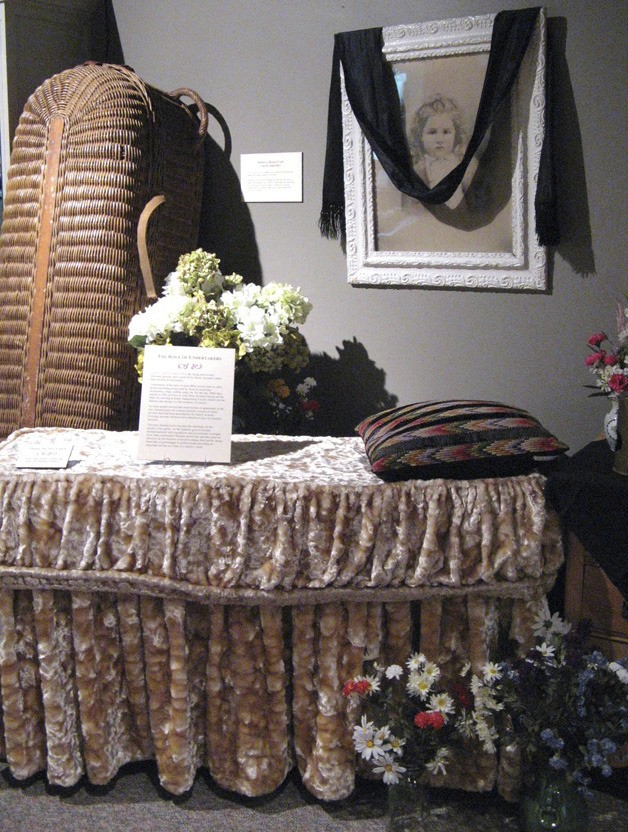“Dead” wastes no time in making an impact.
Visitors to the White River Valley Museum’s newest exhibit – “Dead: Unearthing the Shift in Funeral Practices from Home to Mortuary” – are immediately greeted by the deceased, in this case, a post-mortem photo of Astrid, an angelic-faced Swedish girl in her casket, the family house and cemetery plot captured in the background.
For some, the image might just be a morbid reminder of our impermanence, an acknowledgement that everybody dies eventually. For guest scholar Louise Hull, a sociology professor at Green River Community College, it’s merely an example of the way things used to be.
“Most people didn’t have extra money to take pictures back then. This was their one way of having a lasting memory,” Hull explained. “If you don’t have that resistance to death, it’s not morbid. Now, we’re a youth-oriented culture. The squeamishness comes from our own fear of having to face our mortality.”
Astrid’s photo is just one of many post-mortem pictures – most from the Paul Frecker Collection – used by the exhibit to illustrate the journey that American society has taken in institutionalizing the funeral industry, moving the care of the deceased out of the home and into mortuaries.
In addition to photography, the exhibit also traces the institutionalization of the funeral business with artifacts (on loan from the Kayser Chapel and Crematorium in Moses Lake), ranging from the slumber beds and other items used for home funerals, to the extensive mortician’s tools used to embalm and prepare bodies for burial.
“What’s happened is we’ve moved away from agricultural to urban settings,” Hull said. “Death is no longer a part of our daily lives.”
In years past the majority of Americans lived on farms, where death was an acknowledged part of the cycle of life.
“Farm animals die, the older generations that lived on the farm would die,” Hull said. “With the growth of urban migrations, we moved toward institutions.”
Instead of taking care of the sick and dying in homes, society turned to hospitals to shoulder the load. And once the sick had died, people began to turn to morticians – who were once no more than sellers of funeral supplies – and mortuaries to handle the disposition of the corpse.
Although the switch to an industrialized approach to honoring our dead has provided benefit to grieving families, Hull said, there are drawbacks as well.
“Humans are extremely adaptable,” she said. “We’ve adapted to the way our culture has changed. However, it doesn’t serve us well; death isn’t something we can avoid. Death is inevitable, and that’s a reality some people like to stay in denial about as long as possible. People are ill prepared for their own death and especially the death of their young ones. We get confused, we don’t know what to do. In that case the funeral industry does serve us.”
For museum director Patricia Cosgrove, “Dead” is more than just another exhibit.
“I lost a couple of people over the last year,” she said. “As an adult, I experienced their passing so differently, in a really wonderful way.”
Cosgrove recently took a week off to be with a mortally ill friend, helping to usher her through the dying process.
“It was just a great loving time,” she said.
Additionally, Cosgrove said, her brother-in-law recently died from cancer.
“My sister was with him when he died, and washed his body and got it ready to go,” Cosgrove said. “And those just contrasted so much with my youthful experiences of waving goodbye to my dad in the hospital as they pulled the plug, then leaving because that’s what they did.”
Ultimately, the exhibit – which was sponsored by the Mountain View Cemetery – does not seek to make a judgement on the validity of either the modern way of death or the way it was handled in the past. It merely seeks to educate, Hull said.
“Any time we can expose ourselves to different aspects of the dying process helps to prepare us,” she said.
=====
On exhibit
“Dead: Unearthing the Shift in Funeral Practices from Home to Mortuary” runs through Nov. 6 at the White River Valley Museum, 918 H St. SE, near Les Gove Park. Cost is $2 for adults, $1 for seniors and children.
The exhibit features an “Ask the Mortician” event featuring Gary Klontz of Klontz Funeral Home at 6 p.m. Sept. 15. Guest Scholar Louise Hull provides further insight in her presentation, “A Death Denying Culture,” at 6 p.m. Sept. 29.


